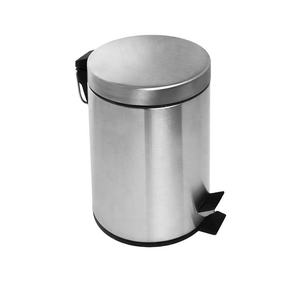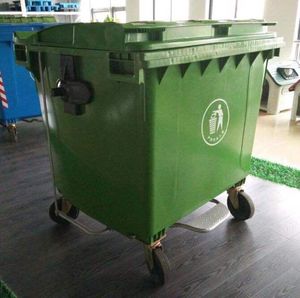(19649 products available)






































































































































































































































The classification of metal waste bins can be based on their structural features, usage requirements, and other specific factors. They can be categorized into different types, as follows:
By usage type
According to the usage of the metal waste bins, they can be classified into three types. First, metal waste bins are commonly used for general purposes. They are designed to hold ordinary waste in offices, homes, and public places. Second, metal recycling bins are specifically designed to collect recyclable materials such as paper, plastics, metals, etc. Third, metal sanitary bins are used in restrooms and other areas where personal hygiene products are disposed of. They usually come with features that ensure privacy and odor control.
By style
There are different styles of metal waste bins that are available in the market. First, pedal bins are equipped with foot pedals that allow hands-free opening of the lid. This helps in easy disposal of waste while maintaining hygiene. Second, swing top bins have lids that swing open from the top to allow for quick and easy waste disposal. Third, push cans have a mechanism where a button or lever is pushed to open the lid. Fourth, trash bins with wheels are designed for easy mobility. Fifth, wall-mounted bins are designed to be mounted on a wall, which helps save floor space and keeps the bin out of the way.
By shape
According to the shape, metal waste bins can be classified into different types. First, round bins have a circular base and body, which makes them stable and less likely to tip over. Second, square bins have a square base and body, providing more stability and ease of stacking and cleaning. Third, rectangular bins have a rectangular base and body, offering more capacity and being more suitable for placing in narrow spaces.
Classic Round Bin
This design is timeless. It often has a smooth, cylindrical shape with a rim at the top. It's usually made from stainless steel or galvanized metal, giving it a shiny or matte finish. The base is often wider for stability, and it may have a dome-shaped lid that fits snugly.
Sleek Rectangular Bin
For places where space is tight, the rectangular waste bin is perfect. These bins have straight sides and a rectangular shape, often with a foot pedal for hands-free opening. They are designed to fit against walls or under counters.
Modern Square Bin
Square bins are similar to rectangular ones but equal in all directions. They often come with a flip-top or swing lid for easy waste disposal.
Bin with Soft-Close Lid
These bins are made to be quiet. When the lid is closed, it lowers slowly and silently. This feature stops noise and stops fingers from getting caught.
Waste Bin with Removable Inner Bucket
These bins make taking out the trash easy. The inner bucket is a separate container that lifts out easily. This design helps people recycle by separating different kinds of waste.
Bin with Foot Pedal
Foot pedal bins are hands-free. People press a pedal with their foot to open the lid. This design is excellent for kitchens and bathrooms, keeping surfaces clean by hiding waste.
Bin with Swing Lid
These bins have a lid that swings open when pushed. Swing lid bins are good for public places where people throw away trash often. The lid swings back to keep waste inside and odors out.
Wall-Mounted Bin
Wall-mounted bins are attached to a wall, saving floor space. These bins are excellent for small areas or where people want to keep things off the ground. They often have a flip-top or slide-out drawer for easy waste disposal.
Recycling Bin Set
With more people recycling, many bins come in sets. Each bin has a label for paper, plastic, metal, or compost. Some sets have different colors to help separate waste so it can be recycled.
Bin with Aesthetically Pleasing Design
These bins look good and work well. They come in many shapes and finishes to match home decor. Some have designer prints or unique shapes, making them part of the room instead of just a place to throw away trash.
Bin with Ventilated Lid
These bins have holes or a mesh design in the lid for airflow. They are great for disposing of organic waste or food scraps, preventing odor and reducing moisture buildup.
Metal waste bins are prevalent in many industries and institutions. They are used in the following settings.
Commercial Settings:
Restaurants, shopping malls, and food courts have a lot of garbage, including food waste. They need large capacity waste bins that are odor resistant and easy to clean. Business offices produce paper, plastic, and food waste. They need waste bins that are aesthetically pleasing and that separate recyclables from non-recyclables. Hotels generate a lot of waste in the guest rooms and in the dining areas. They need waste bins that are stylish, sanitary, and that minimize odors.
Institutional Settings:
Schools generate a lot of waste in the classrooms, cafeterias, and dormitories. They need waste bins that are durable and that encourage students to separate waste for recycling. Colleges need the same thing as schools, but with a higher expectation for style and durability. Libraries generate a lot of waste and need metal waste bins that are quiet (some have noise-dampening features) and that complement the library's decor. Museums and galleries have a lot of waste and need bins that complement the artistic environment and that protect against vandalism.
Healthcare Facilities:
Hospitals and clinics generate medical waste, which must be disposed of properly to prevent infection and contamination. They need metal waste bins that are puncture-resistant, that have tight-fitting lids, and that are color-coded for different types of medical waste. Nursing homes generate a lot of waste and need bins that are easy to clean and that minimize odors.
Industrial and Manufacturing Facilities:
Factories generate a lot of waste and need bins that can handle heavy loads, that resist chemicals, and that can be used for materials sorting. Construction sites generate a lot of waste and need large, rugged bins that can handle rough use and large amounts of debris. Laboratories generate a lot of waste and need metal waste bins that are resistant to chemicals and that can safely contain hazardous materials.
From the perspective of the product itself, business buyers can consider the following factors when choosing metal waste bins:
Material selection:
Choose the appropriate metal material according to the specific application environment and requirements. For example, stainless steel is suitable for wet environments or places with high corrosion resistance, while carbon steel can be used in indoor environments with less corrosion demand.
Durability and quality:
Choose waste bins with good manufacturing quality and durable properties to ensure that they can withstand long-term use and heavy loads. Check the thickness of the material, the quality of the welds, and the overall structural integrity of the product.
Safety and stability:
Ensure that the metal waste bins have sufficient stability and safety to prevent tipping and accidents. Choose bins with anti-tipping design, smooth edges, and properly secured covers.
Cleanliness and hygiene:
Choose metal waste bins that are easy to clean and maintain to ensure cleanliness and hygiene. Select bins with smooth surfaces, removable inner buckets, or cleaning openings to facilitate waste disposal and bin cleaning.
Environmental considerations:
Choose metal waste bins that comply with relevant environmental standards and regulations. Consider selecting recyclable or environmentally friendly materials and supporting waste classification and recycling functions.
In addition to the above factors, business buyers also need to consider their own specific needs and application scenarios. For instance, consider the size and capacity requirements of the waste bin, the style and appearance that match the environment, budget constraints, and other factors. By comprehensively considering these factors, business buyers can choose the metal waste bins that best meet their needs.
Q1: What are the benefits of using a metal waste bin?
A1: Metal waste bins are durable, fire-resistant, and provide better odor control. They are also more sustainable as they can be recycled and reused more effectively.
Q2: How can customers ensure they choose the right metal waste bin for their needs?
A2: Consider factors such as the bin's capacity, the type of waste it will hold, the location where it will be placed, and any specific features or requirements, such as foot pedals or wheels.
Q3: What metal is commonly used in manufacturing waste bins?
A3: Waste bins are usually made from stainless steel, galvanized steel, and aluminum metal.
Q4: Can metal waste bins be customized?
A4: Yes, many suppliers offer customization options to meet specific needs, including branding, color, and design modifications.
Q5: What are the cleaning requirements for metal waste bins?
A5: Metal waste bins should be cleaned regularly with mild detergents and non-abrasive cleaning materials to maintain their appearance and prevent rust.